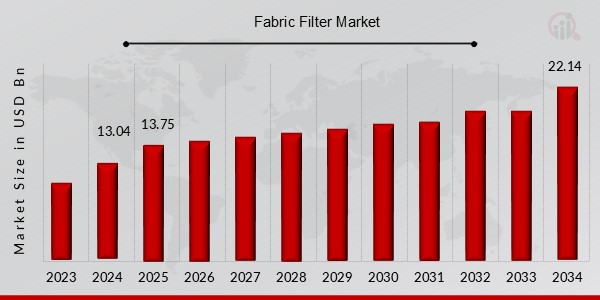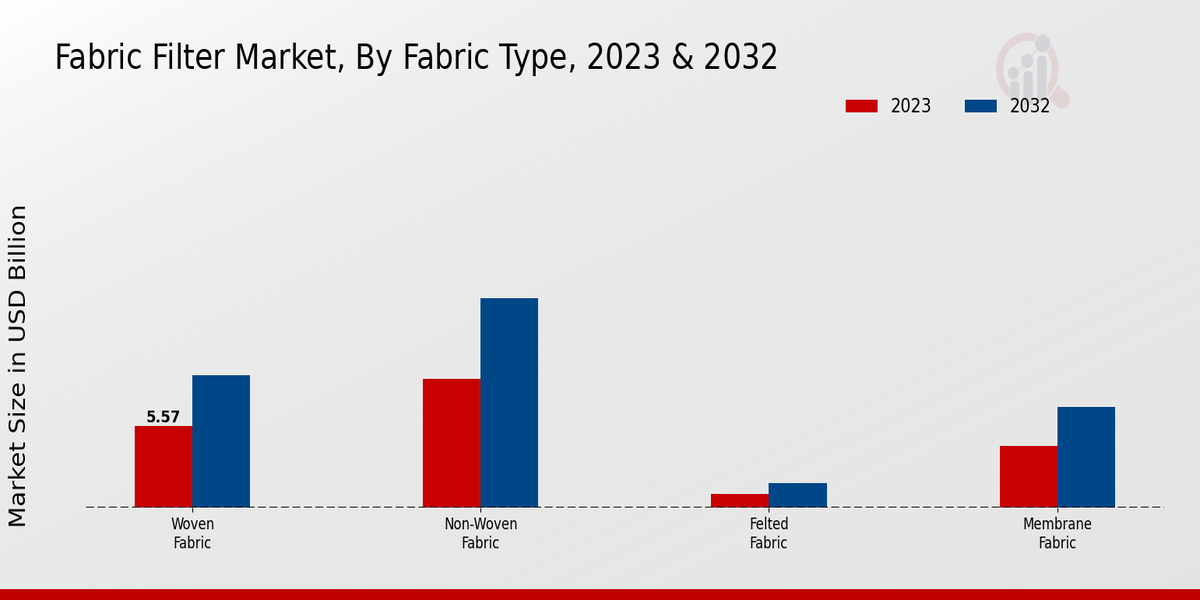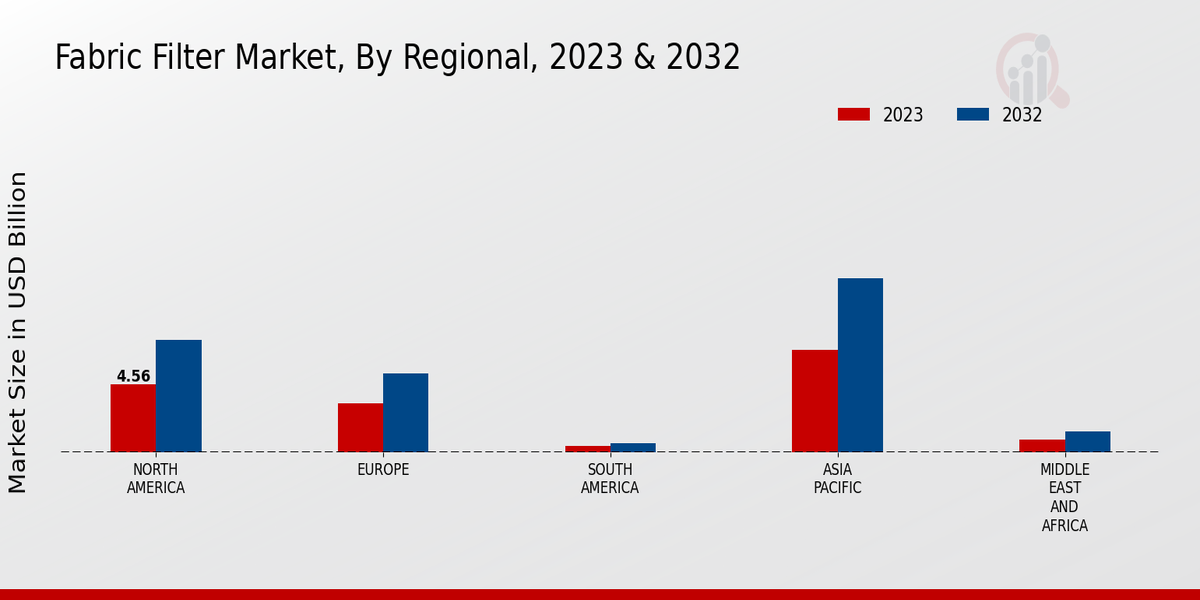Fabric Filter Market Overview
As per MRFR analysis, the Fabric Filter Market Size was estimated at 13.04 (USD Billion) in 2024.The Fabric Filter Market Industry is expected to grow from 13.75 (USD Billion) in 2025 to 22.14(USD Billion) by 2034. The Fabric Filter Market CAGR (growth rate) is expected to be around 5.40% during the forecast period (2025 - 2034).
Key Fabric Filter Market Trends Highlighted
The global Fabric Filter market exhibits significant growth potential due to escalating industrialization and stringent environmental regulations. The increasing adoption of fabric filters in various industries, including power generation, chemical processing and manufacturing, to control air pollution and meet emission standards is driving the market expansion. Furthermore, the rising awareness about environmental sustainability and the demand for energy-efficient filtration solutions contribute to the market's growth. Additionally, technological advancements, such as the development of nanofiber-based filters with enhanced filtration efficiency, are creating new opportunities for market expansion.

Source: Primary Research, Secondary Research, MRFR Database and Analyst Review
Fabric Filter Market Drivers
Rising Demand for Air Pollution Control
Stringent government regulations aimed at curbing air pollution have spurred the demand for fabric filters in various industries. The growing awareness of the adverse effects of air pollution on human health and the environment has prompted governments to implement stringent emission control standards. These regulations mandate the use of efficient air pollution control systems, including fabric filters to reduce particulate matter emissions from industrial processes.The increasing adoption of fabric filters across industries, such as power generation, manufacturing, and mining, is a key driver of the Global Fabric Filter Market Industry. Fabric filters offer several advantages over other air pollution control technologies. They are highly efficient in capturing fine particulate matter, including PM2.5 and PM10, which are harmful to human health. Fabric filters also have a long lifespan and require relatively low maintenance, making them a cost-effective solution for air pollution control.Furthermore, fabric filters can be customized to meet specific industry requirements, making them suitable for a wide range of applications. The growing demand for fabric filters in emerging economies is another significant factor driving market growth. Rapid industrialization and urbanization in these regions have led to increased air pollution levels, prompting governments to adopt stricter environmental regulations. The rising demand for fabric filters in these emerging markets is expected to contribute to the overall market expansion in the coming years.
Advancements in Fabric Filter Technology
Introduction The Fabric Filter Market Industry is expected to witness a significant boom owing to recent technological advancements. Fabric filters have been experiencing an increased demand as industries and manufacturers have been striving to reduce their environmental impact. Technological advancements, such as the emergence of self-cleaning fabric filters have been observed, for example. In addition to that, the introduction of advanced filter media and designs has enabled fabric filters to outperform other filtration devices by achieving greater efficiency in filtration operation while also extending service life and reducing unnecessary energy consumption.The Technology Drives the Fabric Filter Market Industry Innovation in the production of emulsion and advanced use of functional ion exchange fiber as well as co-knitted fabrics have been found to increase the efficiency of particle capture by up to 95%. The emergence of nanofibers and advanced coating technologies have further increased particulates. Advanced sensor technology and intelligent controllers have contributed to the growth of smart filter filters by monitoring system performance and adjusting operating parameters to ensure that minimum energy is consumed during the filtration process.
Growing Adoption in Diverse Industries
The versatility of fabric filters has led to their adoption across a wide range of industries beyond their traditional use in power plants and manufacturing facilities. The increasing demand for air pollution control in various sectors, such as food and beverage, pharmaceuticals and chemicals, has opened up new growth opportunities for the Global Fabric Filter Market Industry. Fabric filters are particularly effective in controlling emissions from processes that generate fine dust and particles.For instance, in the food and beverage industry, fabric filters are used to capture dust generated during grain processing and packaging. In the pharmaceutical industry, fabric filters help control the emission of active pharmaceutical ingredients (APIs) and other hazardous substances. The growing demand for fabric filters in these diverse industries is expected to drive market growth in the coming years.
Fabric Filter Market Segment Insights:
Fabric Filter Market Fabric Type Insights
The Global Fabric Filter Market by types is categorized into Woven Fabric, Non-Woven Fabric, Felted Fabric and Membrane Fabric. Woven Fabric has a significant market share, attributed to its properties such as high filtration efficiency, cost-effectiveness and robustness. Non-woven Fabric is steadily growing in the market owing to its enhanced filtration efficiency and ability to be used in various applications. Felted Fabric finds its application in high-temperature and corrosive regions having excellent resistance attributes. Membrane Fabric is expected to grow higher in the forthcoming periods owing to its efficient filtration and ability to hold fine particles.The Global Fabric Filter Market is expected to reach USD 12.56 billion by 2024, exhibiting a CAGR of 5.6%
.
Source: Primary Research, Secondary Research, MRFR Database and Analyst Review
Fabric Filter Market Application Insights
The Global Fabric Filter Market segmentation by Application is classified into Power Generation, Cement Production, Metallurgical Industry, Chemical Industry, Food and Beverage Industry. The Power Generation segment held the largest market share of 35% in 2023 and is expected to continue its dominance throughout the forecast period. The growing demand for electricity and stringent environmental regulations drive the growth of this segment. The Cement Production segment is another major contributor to the Global Fabric Filter Market, accounting for 28% of the market share in 2023.The increasing construction activities and infrastructure development worldwide fuel the demand for cement, leading to higher adoption of fabric filters in cement plants. The Metallurgical Industry segment is anticipated to witness significant growth over the forecast period due to the rising demand for metals and the need to control emissions from metallurgical processes. The Chemical Industry and Food and Beverage Industry segments are also expected to grow steadily, driven by the need to comply with environmental regulations and ensure product quality.Overall, the Global Fabric Filter Market segmentation by Application offers insights into the diverse industries where fabric filters are employed, enabling manufacturers to tailor their products and strategies to meet specific industry requirements.
Fabric Filter Market Dust Collection Efficiency Insights
The dust collection efficiency segment is a crucial aspect of the Global Fabric Filter Market, directly impacting market growth and revenue generation. This segment categorizes fabric filters based on their ability to capture and retain dust particles of varying sizes. The four sub-segments within this category include 95-99% efficiency: Fabric filters in this range are designed to capture a majority of dust particles, making them suitable for applications with moderate dust generation. 99-99.9% efficiency: These filters offer enhanced dust removal capabilities, effectively capturing a higher proportion of dust particles.They are commonly used in industries with stricter air pollution control regulations. 99.9-99.99% efficiency: Fabric filters in this range provide exceptional dust collection efficiency, capturing almost all dust particles. They are ideal for applications with stringent air quality requirements, such as pharmaceutical manufacturing or cleanroom environments. 99.99-99.999% efficiency: These filters represent the highest level of dust collection efficiency, capturing nearly all dust particles. They are specifically designed for applications where ultra-low dust emissions are critical, such as in the electronics or semiconductor industries.The choice of dust collection efficiency depends on the specific requirements of the application, considering factors such as dust particle size, concentration and desired air quality standards. Higher efficiency filters come with increased cost and pressure drop, so it's essential to strike a balance between efficiency and economic feasibility.
Fabric Filter Market Flow Rate Insights
The flow rate segment is a crucial aspect of the Fabric Filter Market segmentation. It categorizes the market based on the flow rate capacity of fabric filters. The four sub-segments within this segment are Less than 1,000 m3/h, 1,000-10,000 m3/h 10,000-100,000 m3/h. More than 100,000 m3/h Each sub-segment represents a specific range of flow rates, catering to diverse industrial applications. The "Less than 1,000 m3/h" sub-segment targets smaller-scale operations, while the "More than 100,000 m3/h" sub-segment addresses high-volume industrial processes.The Global Fabric Filter Market revenue contribution of each sub-segment varies depending on the demand from specific industries, such as power generation, cement production and metal processing. Market data indicates steady growth across all sub-segments, driven by increasing environmental regulations and rising industrialization.
Fabric Filter Market Filter Media Material Insights
The Global Fabric Filter Market is segmented based on filter media material into Polyester, Polypropylene, Nomex, PTFE and Fiberglass. Among these, Polyester holds the largest market share due to its high efficiency, cost-effectiveness and wide availability. In 2023, the Polyester segment accounted for over 45% of the global fabric filter market revenue. Polypropylene is another popular filter media material, owing to its resistance to chemicals, moisture, and abrasion. Nomex, PTFE, and Fiberglass are also used in specific applications where high-temperature resistance, chemical resistance or flame resistance is required.The growing demand for air pollution control solutions from various industries such as power generation, cement, and steel is expected to drive the growth of the Fabric Filter Market in the coming years.
Fabric Filter Market Regional Insights
The regional segmentation of the Global Fabric Filter Market offers insights into the market's geographic distribution and growth dynamics. North America held the largest market share in 2023, driven by stringent environmental regulations and the presence of major manufacturing industries. Europe followed closely, with a significant contribution from countries like Germany and the United Kingdom. The APAC region is expected to witness substantial growth over the forecast period, owing to rapid industrialization and infrastructure development, particularly in China and India.South America and MEA are expected to contribute a smaller but growing share of the Global Fabric Filter Market, with increasing demand from emerging economies. Segmentation data reveals that North America's market size is projected to reach USD 4.56 billion by 2023, while Europe's market is estimated to be valued at USD 3.27 billion. The APAC region is forecasted to grow at a CAGR of 6.5%, with a market size of USD 6.89 billion by 2023.

Source: Primary Research, Secondary Research, MRFR Database and Analyst Review
Fabric Filter Market Key Players And Competitive Insights:
Fabric Filter Market major players are continuously taking efforts for the development and launch of new products to tap the emerging fabric filter industry demands. Leading Fabric Filter Market key players are also focusing on the expansion of their product portfolio as well as geographical presence with the view to gaining a competitive edge. The fabric Filter Market industry comprises the presence of both well-established as well as medium and small-scale companies. Major strategies observed in the process of Fabric Filter Market business development are product launches, partnerships and collaborations, agreements and acquisitions. Partnerships, collaborations, and acquisitions help companies strengthen and expand their Fabric Filter Market online presence and distribution network across the globe.
Prominent vendors in the Fabric Filter Market are Donaldson Company, Inc., Hamon Corporation, Nederman Holding AB, W.L. Gore Associates, Inc., Parker-Hannifin Corporation, Sly, Inc., and Pall Corporation. Donaldson Company, Inc., is one of the world leaders in fabric filters manufacturing and offers a wide range of filters for power generation, manufacturing, mining, and other industrial operations. Donaldson Company, Inc., is also known for its committed efforts toward innovation and quality in the Fabric Filter Market. Its four manufacturing units’ prominent presence across the globe, and strong distribution network provide a wide range of fabric filters based on specific requirements by end-users.
W.L. Gore Associates, Inc., is another leading player in the Fabric Filter Market industry known for its GORE-TEX membrane technology applied in various filtration solutions. W.L. Gore Associates, Inc. fabrics filters are highly efficient, long-lasting and durable products. Companies’ able handling environmental concerns and sustainability issues is a crucial factor for companies looking for eco-friendly products. W.L. Gore Associates, Inc. brand recognition, coupled with a strong global presence, moved the company to a prominent position.
Key Companies in the Fabric Filter Market Include
- Freudenberg Performance Materials
- Meissner Filtration Products
Fabric Filter Market Industry Developments
Asia-Pacific is expected to dominate the market, accounting for over 40% of the global revenue share. Growing industrialization and stringent environmental regulations are driving the demand for fabric filters in the region.Recent developments include the launch of advanced fabric filter technologies, such as pulse jet and shaker-type filters, which offer higher efficiency and longer lifespan. Additionally, the increasing adoption of fabric filters in power plants, steel mills and other heavy industries is contributing to market growth.
Fabric Filter Market Segmentation Insights
Fabric Filter Market Fabric Type Outlook
Fabric Filter Market Application Outlook
- Food and Beverage Industry
Fabric Filter Market Dust Collection Efficiency Outlook
Fabric Filter Market Flow Rate Outlook
Fabric Filter Market Filter Media Material Outlook
Fabric Filter Market Regional Outlook
| Report Attribute/Metric |
Details |
| Market Size 2024 |
13.04(USD Billion) |
| Market Size 2025 |
13.75(USD Billion) |
| Market Size 2034 |
22.14(USD Billion) |
| Compound Annual Growth Rate (CAGR) |
5.40% (2025 - 2034) |
| Report Coverage |
Revenue Forecast, Competitive Landscape, Growth Factors, and Trends |
| Base Year |
2024 |
| Market Forecast Period |
2025 - 2034 |
| Historical Data |
2020 - 2024 |
| Market Forecast Units |
USD Billion |
| Key Companies Profiled |
Parker Hannifin, Freudenberg Performance Materials, ITT Inc., Nederman, EATON, SPX Corporation, Donaldson Company, TLTTurbo, Hengst SE Co. KG, Energ Air, Meissner Filtration Products, MANN+HUMMEL, 3M, W. L. Gore Associates, Camfil |
| Segments Covered |
Fabric Type, Application, Dust Collection Efficiency, Flow Rate, Filter Media Material, Regional |
| Key Market Opportunities |
1. Growing Industrialization Stringent 2. Environmental Regulations 3. Advancements in Filtration Technology 4. Increasing Demand from Developing 5. Economies Rise in Infrastructure Development |
| Key Market Dynamics |
1. Rising environmental regulations 2. Growing industrialization 3. Technological advancements 4. Increasing demand from emerging economies 5. Focus on sustainability |
| Countries Covered |
North America, Europe, APAC, South America, MEA |
Frequently Asked Questions (FAQ) :
The Global Fabric Filter Market was expected to grow at a CAGR of 5.40% from 2025 to 2034.
The Global Fabric Filter Market was valued at USD 13.75 billion in 2025.
The Global Fabric Filter Market is projected to reach a valuation of USD 22.14 billion by 2034.
The Asia-Pacific region is expected to dominate the Global Fabric Filter Market in the coming years due to increasing industrialization and urbanization.
Fabric filters are primarily used in industries such as power generation, cement production, and chemical processing for air pollution control and emissions reduction.
Major competitors in the Global Fabric Filter Market include companies such as Donaldson Company, Inc., 3M, and Parker Hannifin Corporation.
Growth drivers for the Global Fabric Filter Market include increasing environmental regulations, rising demand for air pollution control solutions, and growing awareness of the harmful effects of air pollution.
Challenges faced by the Global Fabric Filter Market include high maintenance costs, competition from other air pollution control technologies, and fluctuating raw material prices.
Trends shaping the future of the Global Fabric Filter Market include advancements in filter media technology, increasing automation, and the adoption of digital solutions.
The Global Fabric Filter Market is expected to reach a market size of USD 13.75billion by 2034.
















